| Home | Organ Details | Organ Videos | Video Viewing Information | Archives and Gallery | Links | Photo Album | Contact |
Information About the Organ
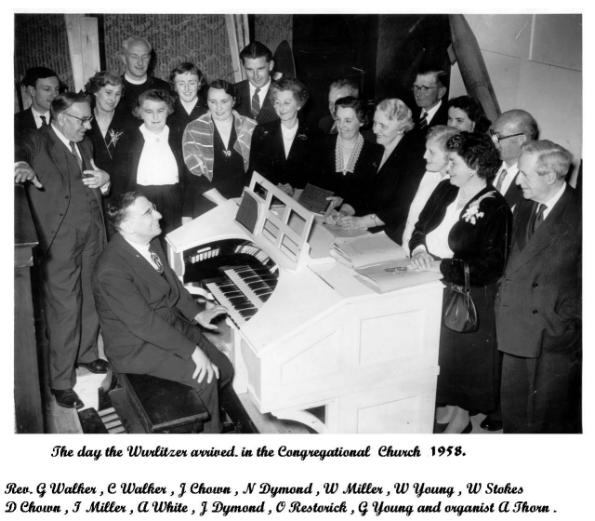 This instrument is extremely interesting historically because it was the very first one of its kind to be imported from America into Great Britain. Its Opus number is 956.
This instrument is extremely interesting historically because it was the very first one of its kind to be imported from America into Great Britain. Its Opus number is 956.
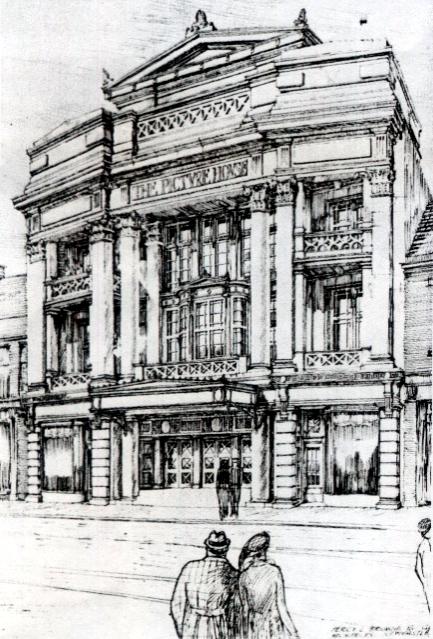
It was specifically ordered for The Picture House in Walsall, Staffordshire and opened there in February 1925.
The photo to the left was taken when the organ arrived at the Church in 1958.
The illustration to the right is taken from an architect's sketch of the Picture House on the Bridge as it was then known locally (From the Collection of Kevin Wheelan), and is reproduced by kind courtesy of "Cinemas in the Black Country" by Ned Williams.
It is ironically fortunate for all of us that the organ was removed from the cinema when it was, as the building was completely destroyed by fire on 2nd March 1971!
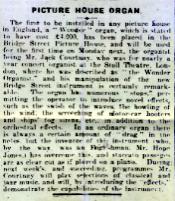 This cutting was reproduced from "The Walsall Observer", dated 24th January 1925. The text reads:
This cutting was reproduced from "The Walsall Observer", dated 24th January 1925. The text reads:
PICTURE HOUSE ORGAN. The first to be installed in any picture house in England, a "Wonder" organ, which is stated to have cost £4,000, has been placed in the Bridge Street Picture House, and will be used for the first time on Monday next, the organist being Mr. Jack Courtnay, who was for nearly a year concert organist at the Stoll Theatre, London, where he was described as "the Wonder Organist", and his manipulation of the new Bridge Street instrument is certainly remarkable. The organ has numerous "stops", permitting the operator to introduce novel effects, such as the swish of the waves, the howling of the wind, the screeching of motor-car hooters and ships' fog sirens etc, in addition to the orchestral effects. In an ordinary organ there is always a certain amount of "drag" in the notes, but the inventor of this instrument (who, by the way was an Englishman, Mr. Hope Jones) has overcome this, and stacatto passages are as clear cut as if played on a piano. During next week's, and succeeding programmes Mr. Courtnay will play selections of classical and jazz music, and will, by introducing the "effects", demonstrate the capabilities of the instrument.
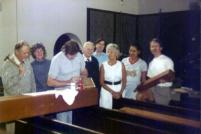
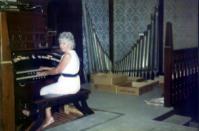 These two undated photos were "found" in February 2009 by Mrs Dorcas Curle, one of the church Deacons, when she was looking through her photo album. It is likely they were taken in the early 1980's. The one on the left shows George Metters, a member of the Cinema Organ Society, re-leathering the stopper on one of the pedal pipes watched by colleagues and church members. The one on the right shows Dorcas seated at the console with some of the other pipes in the
background.
These two undated photos were "found" in February 2009 by Mrs Dorcas Curle, one of the church Deacons, when she was looking through her photo album. It is likely they were taken in the early 1980's. The one on the left shows George Metters, a member of the Cinema Organ Society, re-leathering the stopper on one of the pedal pipes watched by colleagues and church members. The one on the right shows Dorcas seated at the console with some of the other pipes in the
background.
Manufactured in 1924, the ranks and console layout are that of the Style-D which was launched by Wurlitzer in 1921.
For the technically minded, the organ comprises a single divided windchest of modified Roosevelt type, and uses the wiring diagram designation D-500.

There are six ranks of pipes on the windchest, disposed either side of centre in descending pitch order. This is to minimise robbing of wind from adjacent pipes. There is a separate division of the chest for the Vox Humana rank which operates at a lower wind pressure than the other ranks (6"): the main wind pressure being 10".
There are off chest windchests for the pedal Tibia 16' (bass flute), the bass octave of the Strings and Diapason bass. There are separate tremulants for the main and Vox Humana chests.
 Unfortunately all the tuned percussion units, as well as the toy counter (drums, cymbals etc) and also "second touch" features, were removed and "lost" when the organ was installed in this church since they were not considered necessary for church purposes. While this is understandable it was of course a short-sighted policy for such a historic instrument, and was also very sad.
Unfortunately all the tuned percussion units, as well as the toy counter (drums, cymbals etc) and also "second touch" features, were removed and "lost" when the organ was installed in this church since they were not considered necessary for church purposes. While this is understandable it was of course a short-sighted policy for such a historic instrument, and was also very sad.
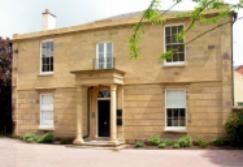 Before the instrument was bought by the church it had been installed at Dormston House Sedgely (West Midlands) the home of Allan Hickling, a local organ enthusiast and Cinema Organ Society member, who had earlier removed it from its original home in Walsall.
Before the instrument was bought by the church it had been installed at Dormston House Sedgely (West Midlands) the home of Allan Hickling, a local organ enthusiast and Cinema Organ Society member, who had earlier removed it from its original home in Walsall.
Dormston House was an ideal place in which to install any pipe organ as it boasted a very spacious music room in addition to a large underground cellar which was easily converted into a most acceptable organ chamber in which to house the workings. There were in fact two organs installed in the building at one point!
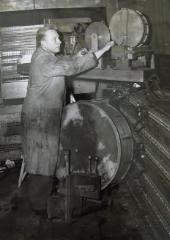 An extract from a Midlands district Cinema Organ Society meeting as reported in the society's Journal (December 1955) reads thus:
An extract from a Midlands district Cinema Organ Society meeting as reported in the society's Journal (December 1955) reads thus:
Alan (Allan) Hickling was present, (at the meeting) and spoke of his (ex-Walsall) Wurlitzer. He said it will be virtually a new instrument when it is re-opened. As this and the concert organ are both in pitch with each other and are in the same room, we should have some fun playing duets! He believes that this will be the only place in the world where a concert and cinema organ are installed in the same room and will be playable together....... (sic)
The instrument became available once again when Allan decided it was not big enough for his needs and decided to upgrade!
The photo to the right shows Allan at work inside the organ chamber at Walsall, carefully removing the toy counter unit.
 It was installed in the church by the Sweetland Organ Company of Bath who evidently made a few mistakes when connecting up the thousands of wires, so that to some extent it has never been entirely satisfactory as the church records clearly show. Anyone looking at the heap of "spaghetti" to the left which is a mass of fine, enamelled, cotton-covered wire will obviously understand why!
It was installed in the church by the Sweetland Organ Company of Bath who evidently made a few mistakes when connecting up the thousands of wires, so that to some extent it has never been entirely satisfactory as the church records clearly show. Anyone looking at the heap of "spaghetti" to the left which is a mass of fine, enamelled, cotton-covered wire will obviously understand why!
Over the years it has provided good service for accompaniment of church services, and many eminent organists visited regularly to see and play the organ. It is still also much visited by organ enthusiasts holidaying locally, and also by many residents of the West Midlands who knew it when it was in its original home.
In 1987 the organ had fallen into a state of disrepair, and although it received regular attention this had been inadequate and the church considered scrapping the instrument, faced with very large estimates for placing it in full working order.

In that year members of the Cinema Organ Society visited to play and, on discovering the situation, two members of COS offered look at the instrument to assess what needed to be done.
Although not an official COS project those two members agreed to take on the task of necessary repairs and tuning on a purely voluntary and part-time basis.
Unfortunately it was soon discovered that there were more problems than was originally anticipated, therefore much more major work was required.
In 1988 a small team of local volunteers, under the guidance of the two COS members, removed all the pipes from the organ chamber upstairs to gain access to the action. Like most organs of this type there is very little room in the chamber for working but, after removal of the pipes, it became possible to overhaul the windchests which were found to be in remarkable condition but contained seventy years accumulation of dirt and dust!

Re-leathering, repairs and re-felting was done as necessary with some magnets being replaced and bellows being re-leathered etc. Only when the pipes were being re-installed was it discovered by accident that some of the original wiring had been connected incorrectly. That problem had also been complicated by several well-meaning organ builders and others over the years who had had a go at solving the problems, without success of course!
The two COS members were still trying to correct the wiring faults, and some of the damage done by others in their attempts to repair what they had perceived as the faults, when this short history was orginally written. The damage was mainly in the relay, which is almost inaccessible. This was another obvious installation error.

Anyone reading the details above would be inclined to think that the organ is in a rather parlous state,
but this is fortunately not the case in the musical sense.
From a player's point of view the instrument is in exceptionally good condition, apart from a few annoying squeaks and cyphers! It is the hidden inner workings which now demand much attention.
The Church is very conscious of the fact that it owns a musical ancient monument, so it is naturally keen to restore the Wurlitzer to its original condition and to preserve it for the generations to come.
